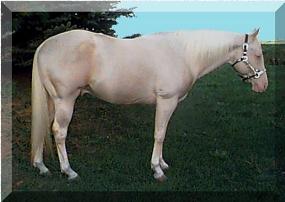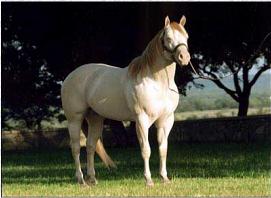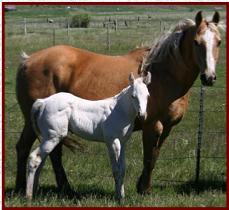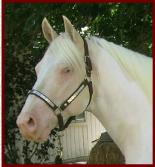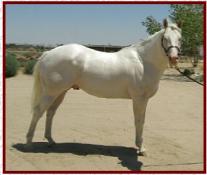Misconception #1- "Double dilute"- Just a fancy name for an albino.
FALSE - It is very important to note that the creme gene only makes the horse's color LIGHTER, but does not remove it, even when there are two present. They cannot make a horse an actual albino-it will always have pigment in it skin, hair and eyes. The only truly pink skin and white hair on a horse will be its MARKINGS, if any.
The point here is to explain why albino and cremello are not the same thing. To make this brief without any genetic letter combinations to confuse and confound, I just want to explain what an albino actually is, and how it comes to exist. And then I'll point out the differences between it and a cremello horse.
There are several different genes that cause albinism in the species in which it exists. We say it does not exist in horses because have never found a horse that meets the criteria to be considered an albino, not because it is impossible in one species while possible in another. In my understanding, even the experts don't know why it doesn't exist in horses. Its existence has just never been proven.
Albinism is created when an offspring receives two recessive genes from its parents... one from each parent. The parents do not exhibit any signs of albinism... a recessive gene is completely masked or "overpowered" by the dominant gene in the pair. So the parent carries the gene without being albino. The different types of albinism all affect pigmentation, and also carry with them some other genetic problems including eye problems, blood clotting problems, and hearing problems.
But the creme gene, which causes a cremello, is not a recessive gene. It is what is referred to as an "incomplete dominant" gene. This means that it shows even when there is only one copy in the gene pair (because it is dominant) but shows more strongly when the horse carries two copies! A horse that carries one creme gene is a very popular animal in today's horse world! He is usually either palomino or buckskin. The single creme gene dilutes the chestnut or sorrel base coat to a gold or cream color and the mane and tail to white. But it does not affect black pigment, so on a bay base coat, it creates the same golden color, but leaves the mane, tail and points black. There are also horses who have no red hair on their bodies and the gene can be hidden there... these are called smoky blacks. Only on true blacks is the gene totally masked, because any brown or red hair will be turned to gold and give those horses a "glow".
When the horse receives a copy of the creme gene from each parent, you have a cremello (on a chestnut base coat) perlino (on a bay base coat) or smoky creme (on a black base coat). But, just as it is not a recessive gene like the albino gene, it also does not carry the associated genetic defects. There is no indication that cremellos, perlinos or smoky blacks have the eye problems, blood clotting problems, or hearing problems that come with an albino gene. This is because the creme gene is a totally different type of gene.
Albino is one thing, caused by one genetic factor. Cremello is another, caused by a completely different genetic factor. So you see that it's not just an argument over what we call them!
Misconception #2- Because of their pink skin, double dilutes sunburn easily and have increased problems with cancer.
FALSE - Graphically illustrated above, there is a difference between pinks. What does this mean? It means that the rules regarding bald faced white horses (like a mostly white paint) and sunburn do not apply to double dilutes. While no research has been done on the subject to date, owners of double dilutes who also have paints or other horses with large areas of white markings report that their double dilutes sunburn much less frequently, if at all.
On the issue of cancers- there has been a lot of research done on this subject, and cancer HAS been known to be associated with certain breeds and colors. One of these breeds is NOT the "American Cream and white" (where many double dilutes of all breeds are registered.) As a matter of fact, pink or double dilute "pumpkin" skin was never mentioned in these studies as being at risk. The breeds with the most problems are appaloosas and draft breeds (associated with squamous cell carcinoma.) And the COLOR with the most cancer problems, to the point that several veterinarians have been quoted as saying "it's not if it's WHEN they get cancer" is grey (associated with melenomas).
Misconception #3- Double Dilutes are lethal whites that somehow survived, and may produce lethal whites.
FALSE - Lethal whites are a product of a terrible gene (LWO) that is associated with the frame overo "paint" pattern. LWO, unfortunately, is not prejudiced, and attacks horses of all colors equally, sometimes even horses that appear to be solid, and therefore wouldn't be thought of as an "overo."
A lethal white foal is an all-white foal that dies, not long after birth (hours or days) due to complications from intestinal tract abnormalities, caused by a genetic defect. UC Davis has identified the one gene responsible for this genetic defect, so lets examine what they have to say about it. The UC Davis web site states this about the appearance of a lethal white foal:
"A lethal white overo foal lacks black pigment in the skin. Foals have blue eyes, white hair and pink skin, but may have small pigmented skin spots or a few colored hairs."
Cremello and Perlino foals are born a very light crème color, with blue eyes and pink skin. However, since they have crème colored hair, and NOT white, you can easily see any true white markings, such as socks, blazes, etc.
As a matter of fact, they are very similar to a light palomino foal. Many palominos also have pink skin and blue eyes when they are first born, and both darken within a couple weeks of birth. Perlinos and Cremellos get lighter instead of darker, and the eyes and skin remain the same. As a Cremello/Perlino horse matures, they can and will fade to such a pale color (nearly white) that such markings may be difficult or even impossible to see without just the right light. But normally, when they are foals, this is not the case. So the difference in appearance between lethal whites and Cremellos is actually fairly easy. As stated above, a lethal white foal IS WHITE, not crème
UC Davis has identified the ONE and ONLY gene responsible for producing the lethal white syndrome. It is associated with horses that carry the overo paint gene. Overo is much more complex genetically than the tobiano coloring gene. There are many different genes that can combine to produce an overo foal. Just ONE of these overo genes is responsible for lethal whites. The gene responsible for the lethal white foals has been named "Lethal White Overo" (LWO).
So, what does this LWO gene have to do with the Cremellos? The answer is- absolutely NOTHING. The LWO gene is NOT the same gene that creates double dilutes. I call Cremellos and Perlinos "double dilutes" because that is exactly what they are. They look the way they do because they received two copies of the Crème dilution gene (double that of a palomino or buckskin: one from each parent). They are NOT lethal whites that somehow managed to survive.
Misconception #4- If you breed double dilutes together you are going to wind up with weak horses with tons of problems.
FALSE - creme genes DO NOT ACCUMULATE. You cannot have more than two creme genes in any horse. For this reason, breeding dilutes, or even double dilutes together will not increase the lightening of the skin, etc.
It's essentially the same as breeding sorrels together: the resutling horse will be a sorrel, getting 2 red genes, one from each parent. Same principal when breeding cremes, just different colors. ALSO- Notice exactly what the creme gene affects: the color of the horse's hair, skin and eyes. Nothing else. It is the same horse with or without the creme genes, only the color is different: it has the same immune system, bone density, resistance to sunburn, stamina and every other strength it would have as a red, bay or black. Anything to the contrary has been disproved by experience and by experiment. If there were any doubts about this, one could just look at the many things that are done with people and their Double Dilutes.





